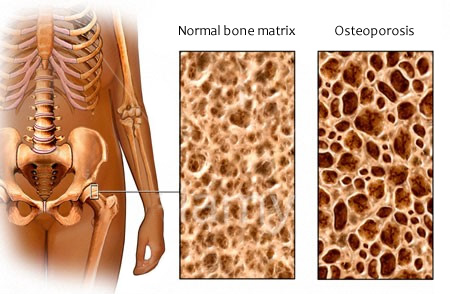Popular osteoporosis drug ‘raises risk of sight problems in elderly’
The following information is taken from the mail online.
Women taking drugs to prevent osteoporosis may have a higher risk of serious inflammatory eye disease, say researchers.
Researchers found women taking bisphosphonates for the first time had a 45 per cent increased risk of the eye disorders uveitis and scleritis.
In rare cases sufferers may develop blindness, although prompt medical treatment usually reverses the symptoms and patients are taken off the drugs.

Osteoporosis is a disease of the bone that leads to an increased risk of fracture. Now scientists say drugs used to treat it could have a detrimental affect on the eyes.
The report in the Canadian Medical Association Journal says the absolute number of people suffering the side effect is low but are warning doctors and patients to be aware of signs such as pain, redness and blurred vision in one or both eyes.
Around 1.4 million British women are eligible for treatment with oral bisphosphonates such as Fosamax, also known as alendronate, because of osteoporosis.
The drugs are the most common form of medication taken long term by thousands of women in a bid to prevent thinning bones.
Previous reports have shown a link between these drugs and the development of anterior uveitis and scleritis, inflammatory eye diseases that can seriously affect vision.
Researchers from the Child and Family Research Institute and the University of British Columbia, Vancouver, carried out a study to quantify the risk.
They included 934,147 people in British Columbia who had visited an ophthalmologist between 2000 and 2007. Of the total, 10,827 were first-time users of bisphosphonates and 923,320 were nonusers.
The researchers found for every 10,000 people taking bisphosphonates for the first-time for a year, 29 developed uveitis compared with 20 among non-users.
The rates were 63 scleritis sufferers per 10,000 new users, compared with 36 cases among non-users. The overall rise in risk was put at around 45 per cent.
Dr Mahyar Etminan, Therapeutic Evaluative Unit, the Child and Family Research Institute and the Department of Medicine, University of British Columbia, said: 'We found that first-time users of bisphosphonates are at an increased risk of scleritis and uveitis.
'The risk of inflammatory ocular adverse events, including scleritis and uveitis, is not highlighted in most package inserts included with oral bisphosphonates.
'Our study highlights the need for clinicians to inform their patients about the signs and symptoms of scleritis and uveitis, so that prompt treatment may be sought and further complications averted.'
The drugs work by disrupting and slowing down normal bone turnover, but the researchers speculate that they cause a surge in inflammatory agents that may trigger eye disease.
Uveitis is inflammation of the middle layer of the eye, which in rare cases can lead to blindness, while scleritis is inflammation of the outer wall of the eye.
Drug-induced inflammatory eye disease is usually reversible with prompt treatment using corticosteroids, and patients are advised to stop taking the drugs.
Last year a study suggested long-term use of bisphosphonates might double the risk of oesophageal cancer, while other reports of side effects have found unusual fractures and irregular heartbeats.
Dr Claire Bowring, Medical Policy Manager of the National Osteoporosis Society said: 'This study seems to confirm what has been reported previously - that inflammation of the eye is a rare adverse side effect and is already currently listed in the Patient Information Leaflets in packages of bisphosphonate treatment here in the UK.
Bisphosphonates are a safe and very effective osteoporosis treatment reducing the risk of future fracture.
'Bisphosphonates are a safe and very effective osteoporosis treatment reducing the risk of future fracture, but if patients have an existing inflammatory eye problem or develop symptoms they should discuss this with their doctor.
'We welcome further understanding of the risks linked with bisphosphonate therapy and this study adds to our knowledge.'



